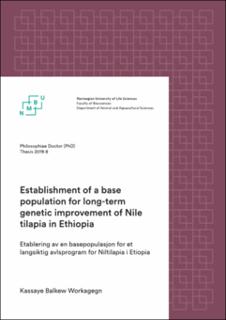| dc.contributor.advisor | Gjøen, Hans Magnus | |
| dc.contributor.advisor | Klemetsdal, Gunnar | |
| dc.contributor.advisor | Dadebo, Elias | |
| dc.contributor.author | Workagegn, Kassaye Balkew | |
| dc.coverage.spatial | Ethiopia | en_US |
| dc.date.accessioned | 2020-04-16T13:19:29Z | |
| dc.date.available | 2020-04-16T13:19:29Z | |
| dc.date.issued | 2019 | |
| dc.identifier.isbn | 978-82-575-1568-3 | |
| dc.identifier.issn | 1894-6402 | |
| dc.identifier.uri | https://hdl.handle.net/11250/2651344 | |
| dc.description.abstract | The success of genetic improvement obtained in fish breeding programs depends on the genetic diversity of the founder populations and how the base population is constructed, as they influence the genetic variation of the traits in the breeding goal. Therefore, the current study was initiated to establish a base population for long-term genetic improvement of Nile tilapia, Oreochromis niloticus, in Ethiopia. To this end, the base population was produced by a complete diallel cross of three Nile tilapia strains collected from three Ethiopian Rift Valley Lakes, Ziway, Koka and Chamo. For this study, 81 and 99 full-sib families were produced in the F1 and in the F2 generations, respectively. From each full-sib family, 20 to 30 fingerlings were randomly selected and tagged using Passive Integrated Transponder tags and reared in low and high input production systems. Genetic parameters for different body traits, such as body weight recorded at 5 months age in F1 and F2 and body weight and fillet traits recorded at 7 months in F1were studied (Paper I-III). Fillet traits were also predicted using body measurements recorded on live fish (Paper II). Lastly, genetic gain and correlated responses for those traits were estimated (Paper III) using a bivariate animal model. | en_US |
| dc.description.abstract | Avlsmateriale av høy kvalitet er avgjørende for å sikre produktivitet, lønnsomhet og god ressursbruk i enhver akvakulturproduksjon. For å oppnå dette ble det samlet inn Niltilapia (Oreochromis niloticus) for å etablere en solid basepopulasjon og starte et avlsprogram for denne arten i Etiopia. Basepopulasjonen ble etablert ved å først testkrysse tre stammer av Niltilapia: Ziway, Koka og Chamo. Disse var samlet fra tre ulike innsjøer i Riftdalen. I hver av de to generasjonene som til nå har blitt produsert fra denne basen ble det laget 180 familier tilsammen, 81 i F1 og 99 i F2. Fra hver familie ble ca 30 yngel valgt ut og merket ved hjelp av elektroniske merker (PIT-tags) og satt ut i to ulike produksjonssystemer, et med intensiv fôring og et med mindre intensiv fôring. | en_US |
| dc.language.iso | eng | en_US |
| dc.publisher | Norwegian University of Life Sciences, Ås | en_US |
| dc.relation.ispartofseries | PhD Thesis;2019:8 | |
| dc.rights | Navngivelse-Ikkekommersiell-DelPåSammeVilkår 4.0 Internasjonal | * |
| dc.rights.uri | http://creativecommons.org/licenses/by-nc-sa/4.0/deed.no | * |
| dc.subject | Fish breeding | en_US |
| dc.subject | Heritability | en_US |
| dc.subject | Growth trails | en_US |
| dc.subject | Genetic correlations | en_US |
| dc.subject | Prediction equations | en_US |
| dc.subject | Genetic response | en_US |
| dc.title | Establishment of a base population for long-term genetic improvement of Nile tilapia in Ethiopia | en_US |
| dc.title.alternative | Etablering av en basepopulasjon for et langsiktig avlsprogram for Niltilapia i Etiopia | en_US |
| dc.type | Doctoral thesis | en_US |
| dc.description.version | submittedVersion | en_US |
| dc.subject.nsi | VDP::Agriculture and fishery disciplines: 900 | en_US |

